Keep the Juice Flowing: The Best Home EV Chargers for 2024, Tested

"Hearst Magazines and Yahoo may earn commission or revenue on some items through these links."
This article was updated in May 2024 with new information. We plan to update this article regularly as we test additional units.
Okay, so you bought your first electric vehicle. Now what? There are a number of ways in which EV ownership will be different from having a vehicle with an internal-combustion engine, but a big one you need to figure out immediately is charging.
Trust us, you'll want to be charging at home as much as possible. This has two significant benefits: Charging can be accomplished when the vehicle is otherwise parked, and home charging is substantially cheaper (roughly one-third the cost) of DC fast-charging. On average, an EV charger will have an up-front cost of between $400 and $500.
Key Takeaways:
The ChargePoint Home Flex EV Charger is our pick for Best Overall thanks to the excellent ChargePoint app, featuring a friendly user interface and nuanced cost tracking—down to the penny.
The Emporia is our pick for Charger on a Budget because of its affordable price without sacrificing anything in the way of features.
Tesla's Universal Wall Connector is another great option, in part because it comes with a built-in adapter to switch between J1772 and NACS/J3400 plug types.
When I began this test, I installed a dedicated 240-volt outlet in my garage—just like how a new EV owner would need to. I then tested these chargers with Car and Driver's long-term Tesla Model 3, Rivian R1T, BMW i4, and Hyundai Ioniq 5—among various other test vehicles—taking notes on each charger's performance in normal, daily use.
This test took months of assessing thanks to the multitude of hours I charged to gather data. Because the EV charging market is exploding, I plan on updating this article with new products and testing data twice a year.
EV Charging at Home
EV Charging Levels:
Level 1: Uses 120-volt AC electricity to charge (i.e., a standard household outlet) with an output of roughly 1 kilowatt. Takes days to charge.
Level 2: Uses 240-volt AC electricity to charge with outputs generally between 6 and 19 kilowatts. Can charge an EV with a modestly sized battery overnight.
Level 3/DC Fast-Charger: Uses 400- or 800-volt DC electricity to charge with output ranging from 50 to 350 kilowatts. Can charge an EV's battery from 10 to 90 percent in as little as a half-hour. Many public chargers are this type, but they're illogical for home use due to their high cost.
Output:
This is how much charging power is being sent to your EV, which is measured in kilowatts. (The voltage of the electrical circuit times the amps of current flowing equals the power in watts; 1000 watts equals a kilowatt. E.g., a 240-volt outlet drawing 32 amps of current is outputting 7.7 kW of power.)
Connector Types:
This is what you need to connect your charging equipment to your EV. For at-home chargers like the products in this list, there are two main types to keep an eye out for: J1772 and Tesla's North American Charging Standard (NACS or J3400). Thankfully, adapters to switch between each connector type are easily available, so limiting your purchase to whatever connection your vehicle features isn't necessary.
Cost to Install an EV Charger at Home:
This really depends on if you have enough spare electrical capacity. If so, you might be able to run a new line for a few hundred dollars. If not, adding capacity to your home's electrical system can cost a few thousand. More on that below.
Tax Breaks for EV Charging Expenses:
The sweeping Inflation Reduction Act reinstated a federal tax credit of 30 percent of your total costs (capped at $1000). Electrical upgrades, wiring, and the charger itself all qualify for this credit—which is set to be in place through 2032.
Things to Consider
Household Circuit Output
Your home's electrical circuit is rated for a certain amount of maximum amperage. Since EV charging can demand anywhere from 24 to 80 amps, it's important to see what additional capacity your home has above your current electrical needs, such as furnace, air conditioning, oven, clothes dryer, etc. Check the main fuse in your breaker box to see the amperage rating—that's the maximum your home can handle before blowing that main breaker. If you have 150- or 200-amp service or higher, you may have enough wiggle room to add charging without an upgrade. But you'll need to measure your house's peak electrical use and consult an electrician. We recommend using a modest 40- or 50-amp circuit due to its ability to charge most EVs overnight while keeping costs down. You will need a certified electrician to verify your home's circuit capacity and install any equipment or upgrades necessary. Some EV charging equipment, such as this Emporia unit, provide load management, which means it constantly monitors your house's overall output and will automatically lower the draw of the charger if necessary to never exceed your house's capacity.
Charge Rate
The charge rate is expressed in kilowatts of power—volts times amps equals watts, 1000 watts equals a kilowatt—which can be used to estimate charge time. If you're charging at 6 kilowatts and your EV has a 60.0-kWh battery, the charge time from empty to full will be roughly 10 hours. (It will actually be slightly longer due to losses during charging and slowing down of the charge rate as the battery nears 100 percent.) The charge rate is affected by three factors and will be limited to the lowest of these: the output of the household circuit, the charging equipment, and the vehicle's onboard charger.
Wi-Fi Connectivity
If you wish to keep track of your EV's electrical use and cost, you'll want a home-charging unit with Wi-Fi connectivity. This allows you to monitor charging, receive alerts, and control the unit via an app.
Variants
Most of these EV chargers offer different variants to suit your needs. These variants (hard-wired or plug, different output capabilities, and varying cord lengths) are typically offered at slightly different prices. Make sure you look at all the various options from any manufacturer.
Outdoor Rating
If you'd like your EV charger to be mounted outside, it's perfectly doable. Each charging unit we tested has an outdoor-grade rating according to either the National Electrical Manufacturers Association (NEMA) or Ingress Protection (IP) standards. There's additional information below on deciphering these ratings below in our FAQs section.
The Best Home EV Chargers
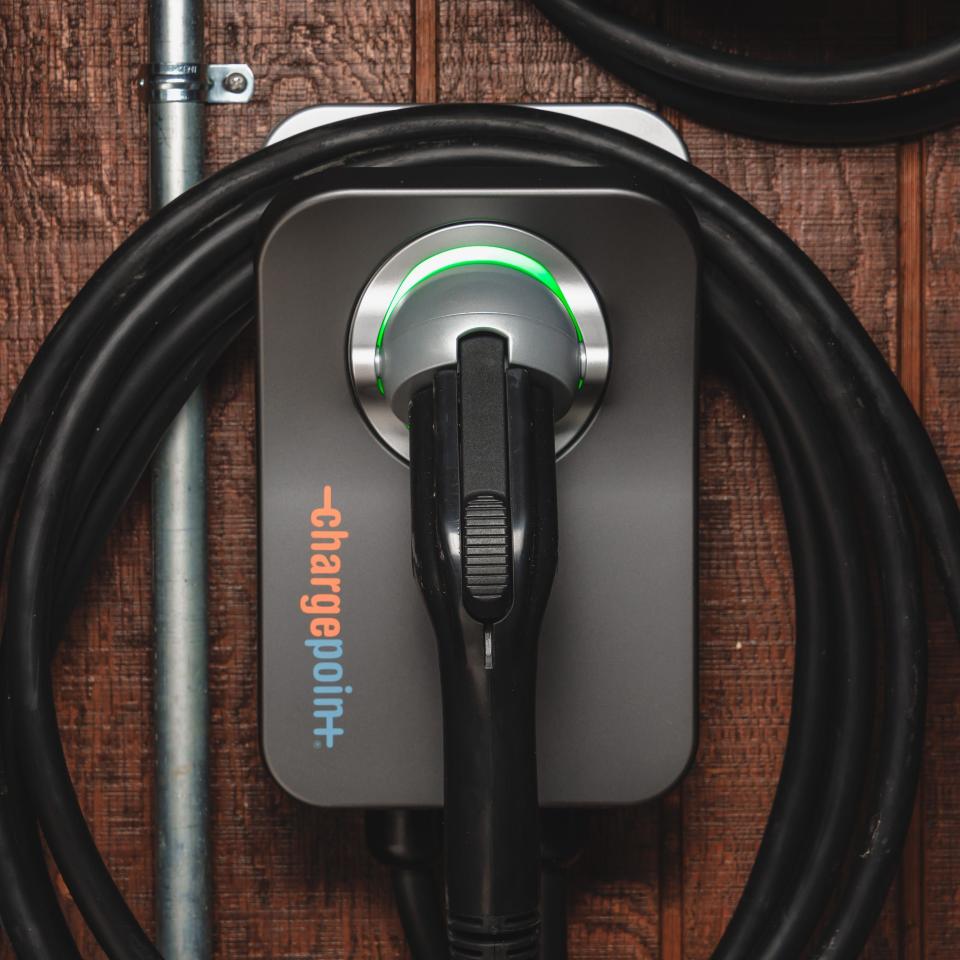
ChargePoint Home Flex Electric Vehicle Charger
amazon.com
$599.00
Michael SimariChargePoint is one of the largest providers of public charging, with thousands of units nationwide. Its Home Flex unit tested here integrates into the same app used to connect to the company's public units. You can add your vehicle in the app, which tailors the percentage of the battery replenished and number of EPA miles added to your specific vehicle.
We found the app to be very user-friendly, with the best displays for charge-rate graphs, and it also shows the total charge time and total energy output during each charge. Furthermore, it offers the ability to schedule charging times to take advantage of variable-cost electricity during off-peak hours (most EVs also allow this to be configured in their settings menu).
The ChargePoint app has the most nuanced cost tracking, allowing us to select from among dozens of possible rate plans from our local utility to pinpoint the actual cost of charging down to the penny, even when on a variable rate.
We also appreciate the simplicity of the built-in notch at the top of the unit to wrap the cord around and that the plug latches onto its dock in the center; many other units require mounting a second cord-management device.
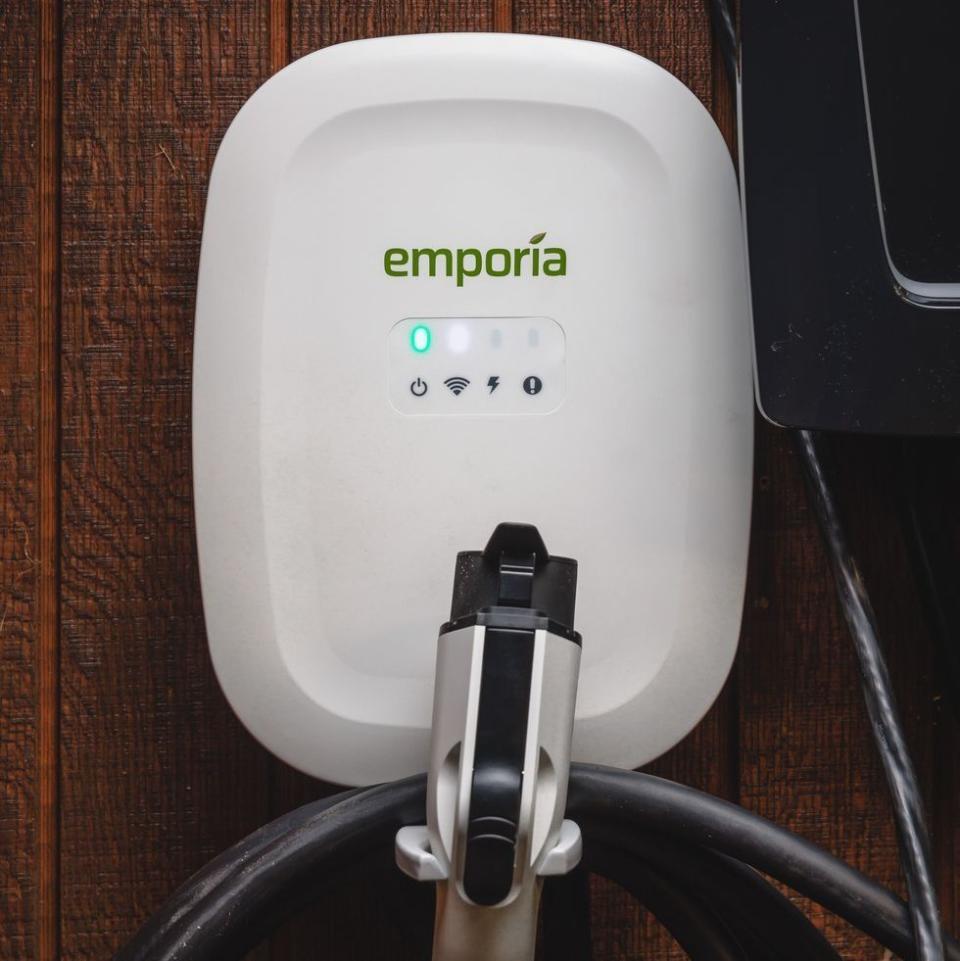
Emporia EV Charger
amazon.com
$399.00
Michael SimariEmporia offers a vast library of electricity-monitoring devices, from typical smart outlets to a system that tracks every circuit in your fuse panel. This entire electricity-tracking universe is integrated into Emporia's app, including the ability to link your EV to the app through the Smartcar API. But if you're just using the EV charging equipment, navigating around all of these unused areas makes the app seem overly complex.
Otherwise, this is an impressive Wi-Fi-connected entry at a price hundreds of dollars less than the JuiceBox or ChargePoint. The 11.5-kW-output capability is at the high end of this roundup. And short of a couple of features, such as using a specific vehicle to estimate the miles or battery percentage gained, the Emporia has just about everything, including detailed electricity pricing using your actual utility plan like the ChargePoint.
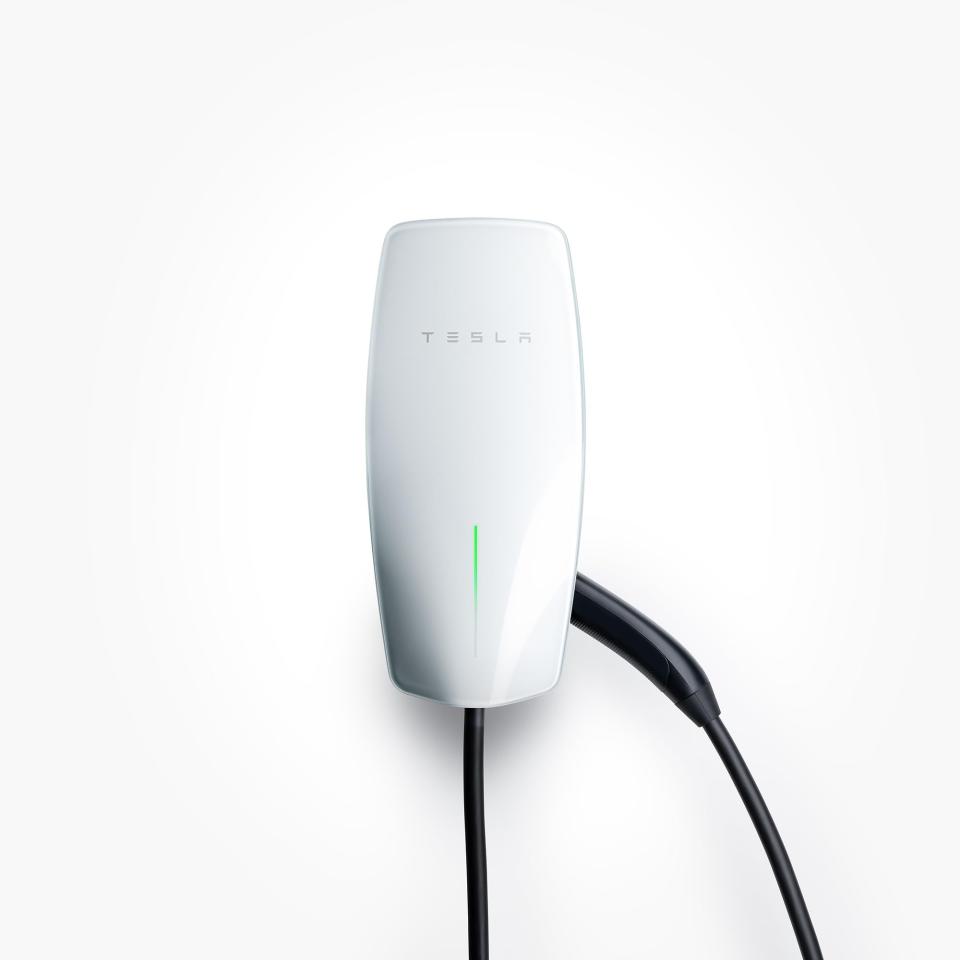
Tesla Universal Wall Connector
amazon.com
$580.00
Michael SimariThe Universal Wall Connector is Tesla's latest home-charging offering, which has a built-in adapter to switch seamlessly between J1772 and NACS plug types. It's significantly thicker than the standard Wall Connector with the Tesla plug, but there's a reason for that: the adapter. At first, it appears to be a simple contraption that slides onto the end of a typical Tesla connector, but it's actually electronically locked into place so the adapter can't go missing. Nifty.
Power output remains the same from the standard Wall Connector, peaking at 11.5 kilowatts, available only in a hardwire configuration, and ability to power share with other Wall Connectors.
In other big news, the unit integrates into the Tesla mobile app to allow monitoring of energy use, which is mandatory if you want to track efficiency like we do with all of our test cars. Once the charging unit is installed, it must be commissioned via a separate Tesla One app, but thankfully any DIYer can create an account to set up the maximum output for the circuit the unit is connected to, and users can also specify certain Teslas to allow to charge at the unit while blocking others. Unfortunately, that functionality doesn't carry over to non-Tesla vehicles.
The slimness of the Wall Connector's 24-foot-long cable continues to impress us, as it matches the output capacity of thicker cables. This makes the cord easier to maneuver and leaves a smaller gap when the garage door is closed on it when charging a vehicle in the driveway.
Price-wise, the Universal is slightly more expensive at $595 versus $475 for the standard Wall Connector, which is in line with what you'd pay for a standalone adapter. For a mixed-EV household or to future-proof your home-charging setup, this is a great solution.
For an in-depth review of the Universal Wall Connector, check it out here.
Other Home EV Chargers We Tested
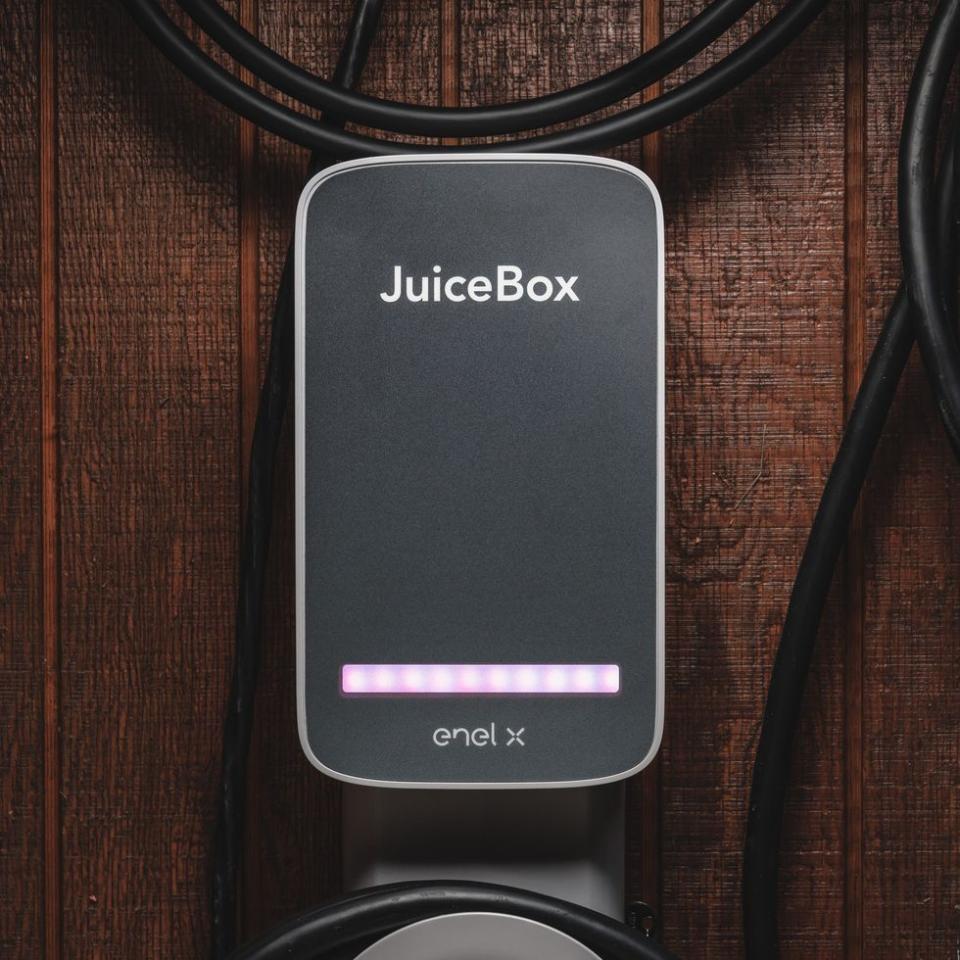
JuiceBox 40 Smart EV Charging Station with WiFi
amazon.com
$699.00
Michael SimariWhen we first tested these charging units in 2022, we liked the JuiceBox best. Since then, the company redesigned its app, so we gave it another go. We were surprised to find the app to be less intuitive to use.
Certain features, such as showing the charge curves for past charges, are gone, and this app annoyingly logged us out far more frequently than the others. Nevertheless, the JuiceBox is still one of the most feature-rich Wi-Fi-enabled Level 2 chargers.
One small advantage for the JuiceBox is that it is offered in a number of output levels, and if your household circuit can't take full advantage of the maximum, choosing a lesser variant can lower the price. In addition to the 40-amp version we tested, there's a 48-amp version that's at the high end of this group and a 32-amp version that costs slightly less (since we were using a 40-amp circuit, we couldn't take advantage of the JuiceBox 40's full output anyway).
Like the ChargePoint unit, the JuiceBox provides energy output and charge time for each charging session, various adjustable notifications, and the ability to set up customized charge times to take advantage of differing electricity pricing. But it can't match ChargePoint's nuanced utility pricing information or the Emporia’s low price.
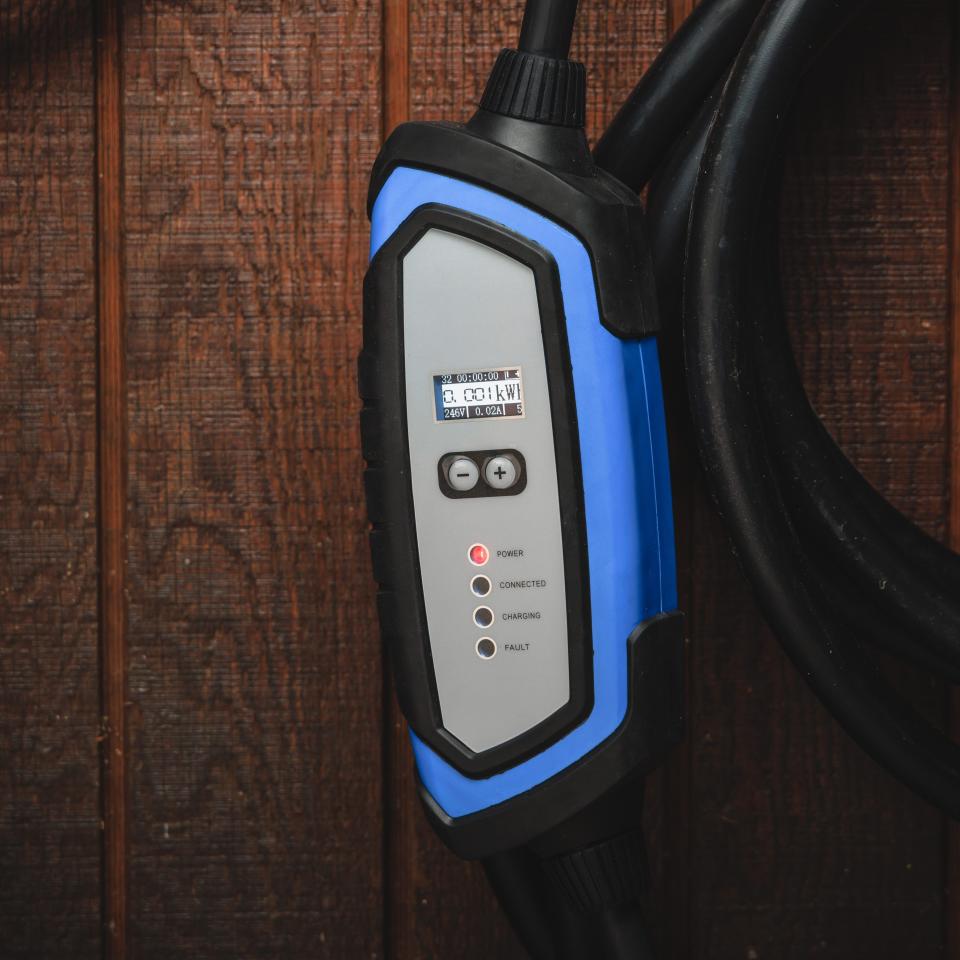
Lectron 32 Amp
walmart.com
$237.95
Michael SimariThis Lectron is one of the cheapest options, so it's not surprising that there's no wall mount, but a simple hose reel or hook mounted to the wall could take care of that. Even though the Lectron isn't a "smart" unit with Wi-Fi capability, it has a small LCD screen that displays voltage, amperage, charge time, energy (kWh), and temperature.
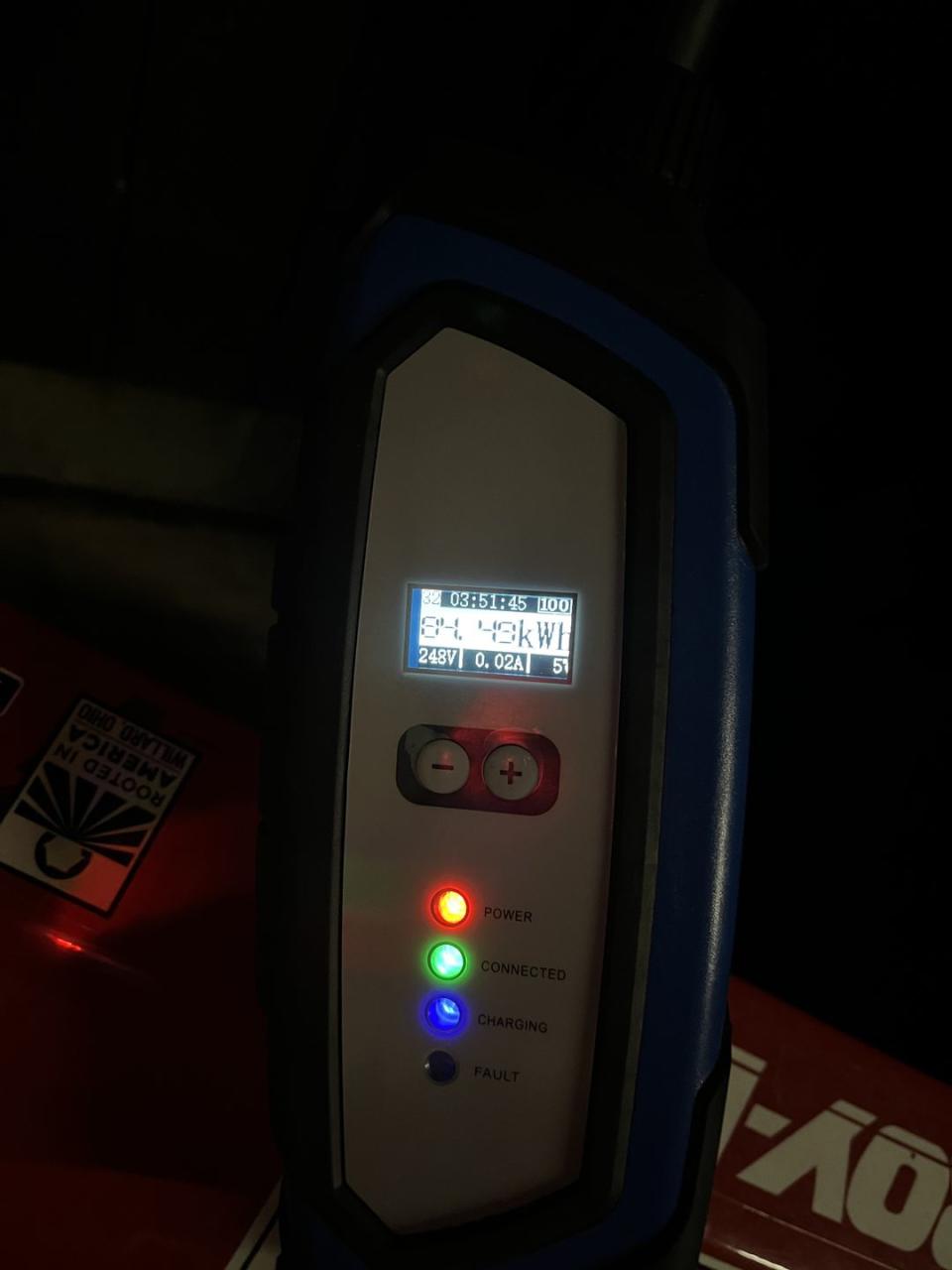
This unit came with no instructions, but with only two buttons, it wasn't too hard to figure out that holding down the "+" was how to set the limit on current, which can be adjusted among 10, 13, 16, or 32 amps of output to match your wall circuit. When you plug in, charge time starts over, but the kilowatt-hour readout doesn't, so if you want to monitor individual charges to track your car's efficiency, you have to unplug and replug before every charge.
If you want to track your charging fastidiously, one of the Wi-Fi-connected units is probably a better choice, and the Emporia doesn't even cost much more.
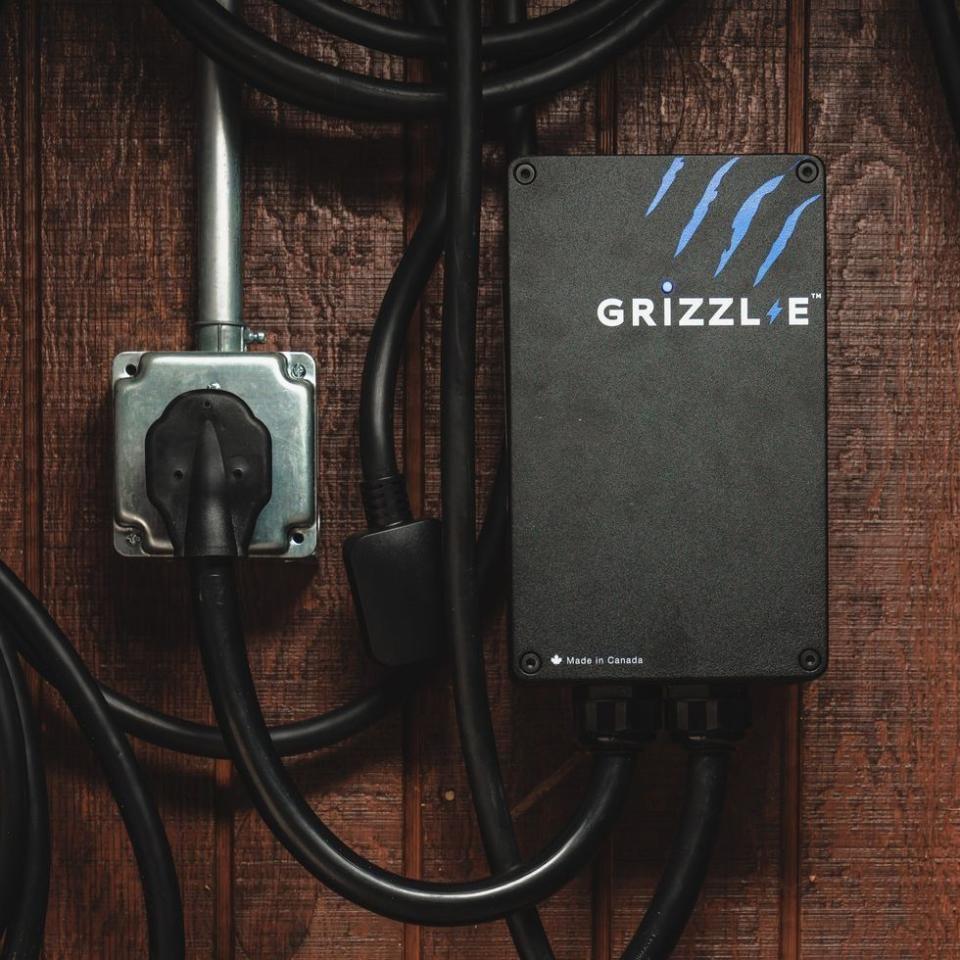
Grizzl-E Smart Connect EV Charger
$395.99
Michael Simari - Car and DriverThe promise of the Grizzl-E Smart is that it can theoretically pair with any EV charging app that uses the OCPP (Open Charge Point Protocol) 1.6, and it's one of the cheapest smart units. Unfortunately, it took months to get ours to connect.
Initially, Grizzl-E said its unit could work with either AmpUp or ChargeLab apps, but now it's only the latter. It appears that Grizzl-E has streamlined the connection process considerably since we first tried using this unit, and we were eventually able to get a firmware update and connect it to the ChargeLab app.
Grizzl-E touts the ruggedness of its beefy aluminum enclosure, with videos on its website showing a small off-road vehicle running over it (which seems completely unnecessary for a thing that's mounted on a wall in or outside your garage). It also had the thickest cables, which were consequently the most resistant to hanging up after charging. A wall mount for the cable is included.
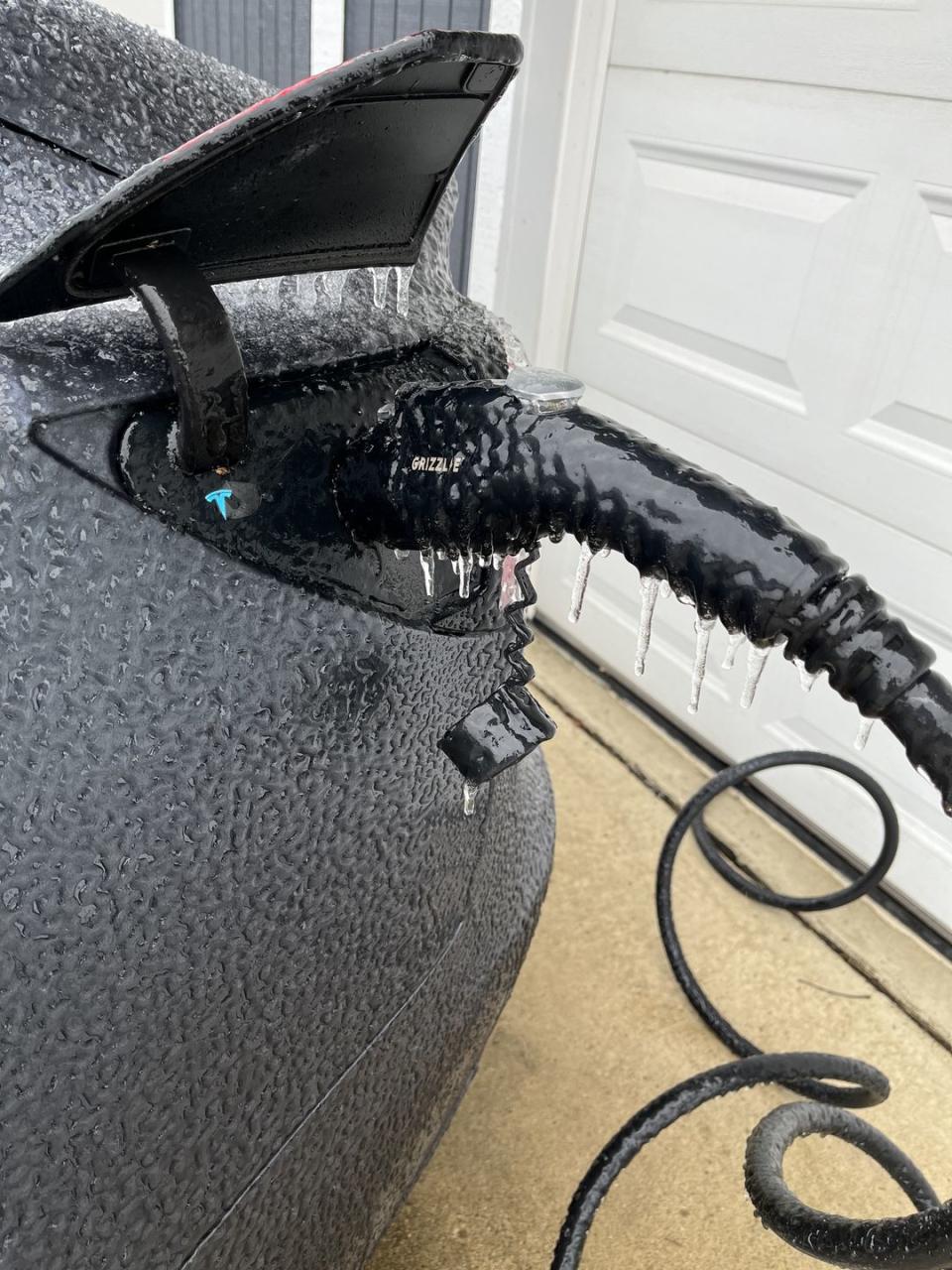
Like the other units, this one can adjust among various output levels, but that's most difficult to accomplish in the Grizzl-E. Rather than change it via the app, you have to take off the front cover and toggle DIP switches. The unit can, however, be preordered to a specific setting to save that hassle. The cover also must be removed to reset the Wi-Fi connection, which we did at least a half-dozen times when trying to get ours to connect.
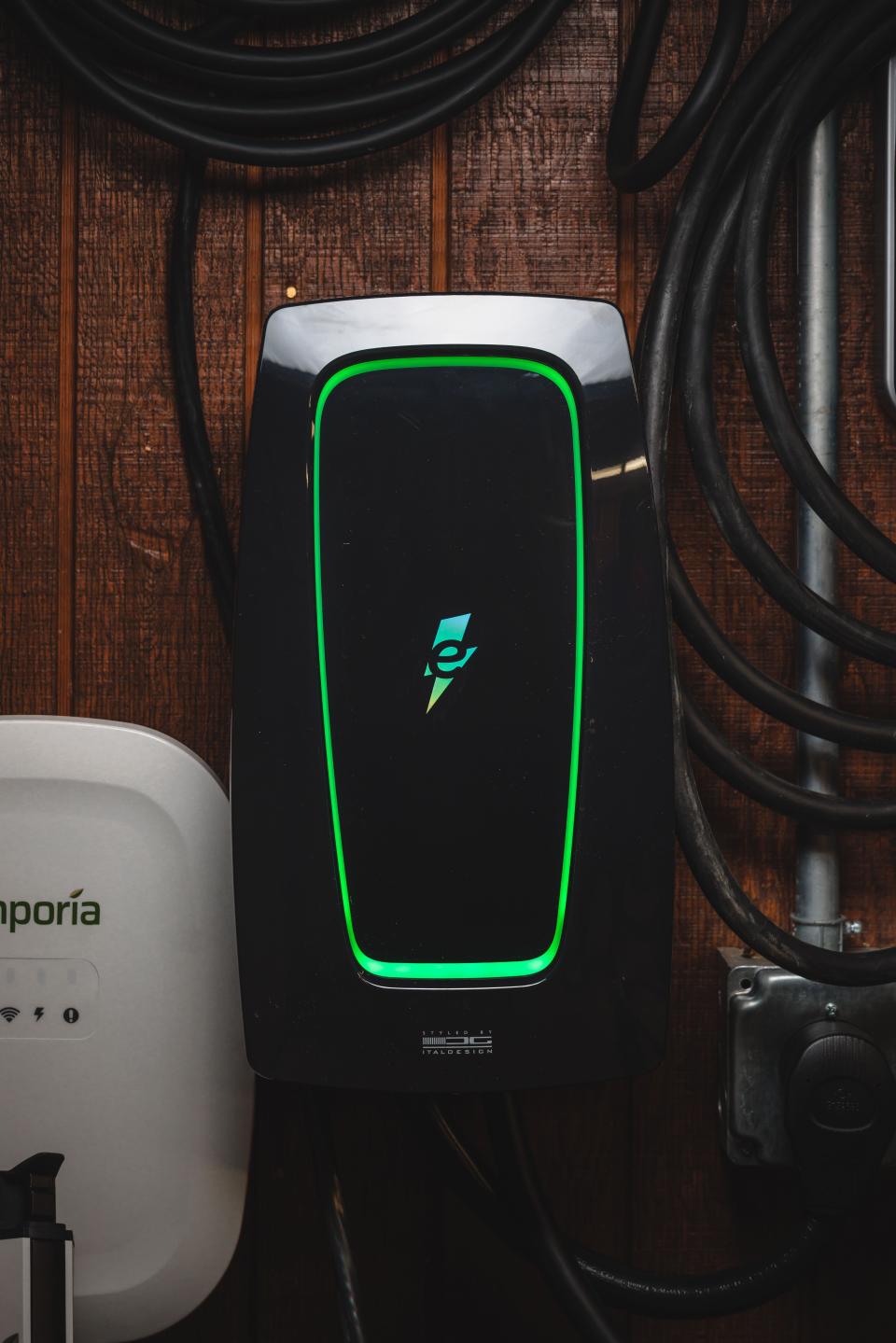
Electrify America EV Charger
amazon.com
$649.00
Michael SimariAs with our top-pick ChargePoint unit, this Electrify America home charging station integrates with the same app used for the company's public fast-chargers (most EV owners likely already have it on their phone).
Setup is easy—the app offers the ability to scan the unit's barcode to add it to your account and connect it to Wi-Fi. But the short cable that plugs into the house's outlet limits mounting options. And we're not sure why this unit is so large, but it's far bulkier than the others and still doesn't include any cord management, which is handled by a separate holster that is included and mounts to the wall.
Despite that the Italian design house Italdesign is credited on the enclosure for the design, we don't think it's nearly as sleek as the Tesla Wall Connector.
After successfully tracking the first charge, our unit stopped communicating with the app, despite still indicating it was connected. After trying every possible reset, we spent a half-hour with the support line doing the same, none of which fixed the issue. After we followed instructions to send a follow-up email with a screen grab from the app, we never heard back. (Update: After just over two months, we received a follow-up email offering to replace the unit under warranty.)
But even the one time it did work, we didn't like that it doesn't display a charging curve or indicate when charging stopped. That info comes in handy when trying to manage charge-time windows to potentially take advantage of variable electricity rates and make sure the car has enough time to charge before you plan to depart (e.g., after the car is plugged in overnight, you don't know whether it was fully charged hours before your departure or minutes before you're leaving).
How We Tested EV Chargers
When putting together this story, I went down the same path a new EV owner would, starting with installing a dedicated 240-volt outlet in my garage. We have charging at the Car and Driver office, but I needed a proper setup at home to support all of the EVs we're reviewing these days.
I was able to add a 40-amp circuit to the existing electric service in my house without a pricey upgrade to run additional capacity, so that's why I landed on a 40-amp outlet versus a 50-amp setup.
To be able to easily switch among the units, we ordered the NEMA 14-50 plug-in variant of each charging device. (Note: Tesla doesn't sell a version of its Wall Connector with a plug, so to keep our test comparable, I wired one in myself to connect to our NEMA 14-50 outlet.)
In the first round of testing, I used each unit to charge our long-term Tesla Model 3 numerous times over a period of months. I then compared the electricity output from the wall to what the Model 3 reported made it into its battery pack using the third-party (and very cool) TeslaFi software.
Recently, I tested a few new units along with the favorites from before using our long-term Rivian R1T, BMW i4, and Hyundai Ioniq 5, verifying the energy delivered to the vehicle with an inline electrical meter. Despite varying cord lengths and thicknesses, there was no measurable difference in performance or efficiency (which averaged roughly 5 to 8 percent charging losses).
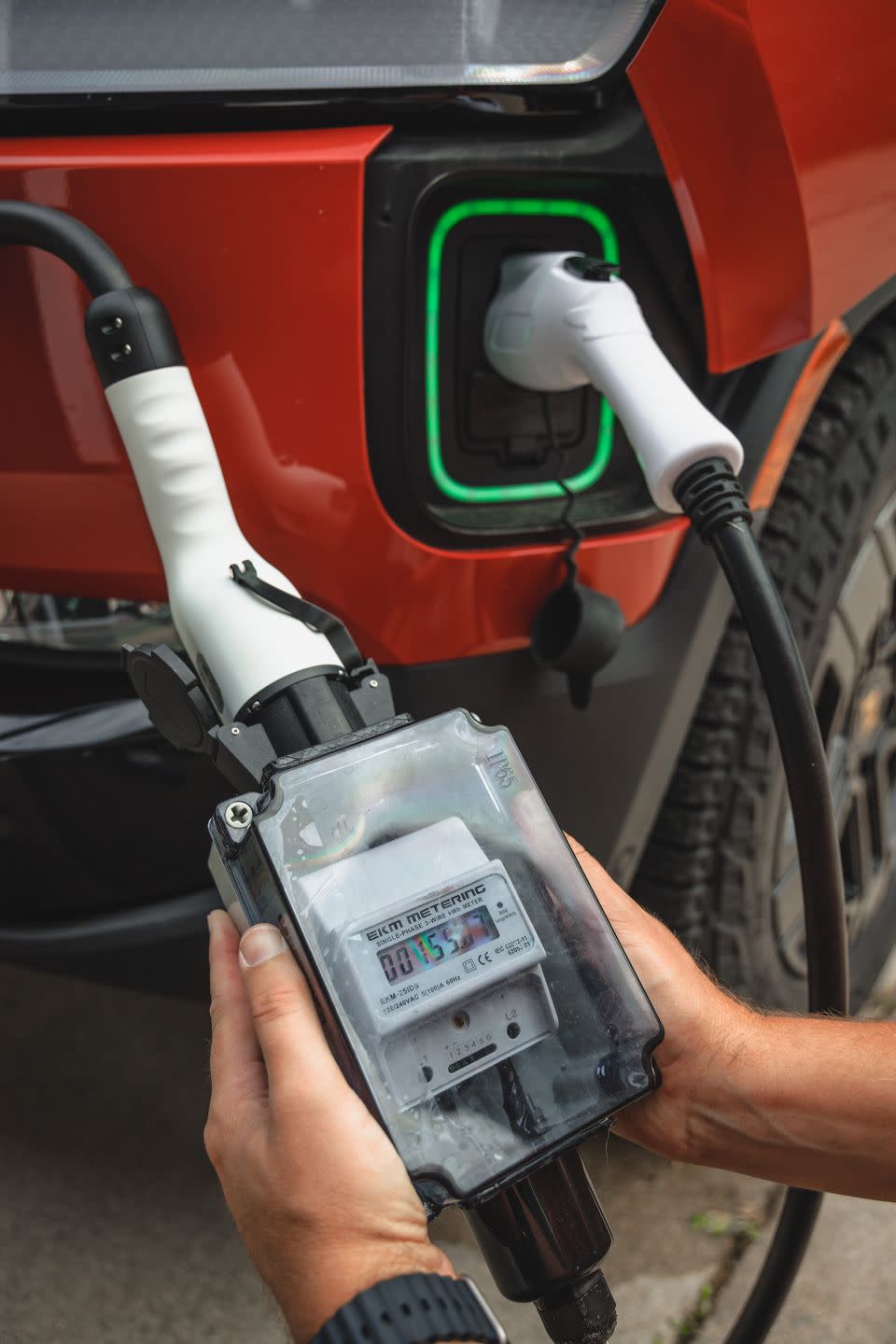
FAQs
What are the different types of EV chargers?
Charging capability is categorized into three tiers. Level 1 and Level 2 use 120-volt and 240-volt AC electricity, respectively, which is what your house is wired for.
Level 3, also called DC fast-charging, is high-voltage (400 to 800 volts) DC charging that takes place at a dedicated public EV charger and charges far faster. DC fast-chargers can cost hundreds of thousands of dollars to install, so it's not something you'd put in at home.
Are all home EV chargers the same?
Home-charging equipment is analogous to a USB cable to charge your phone. It connects the electricity in your house to your car, and in that way they're all similar.
The main differences are their output capability—typically expressed in either amps (e.g., 32, 40, 48 amps) or power (e.g., 7.7, 9.6, 11.5 kW), which equates to charging speed—and whether they are Wi-Fi connected, which typically allows charging to be monitored and controlled remotely via a phone app.
What's the difference between Level 1, Level 2, and Level 3 charging?
The charging "Levels" generally refer to charging speed. Level 1 is extremely slow (think multiple days for a full charge), Level 2 is adequate for at-home use (an EV can charge overnight), and Level 3 is the fastest (a half-hour top-up might add 80 percent charge). Technically, the difference is the voltage at which energy is input into an EV.
Level 1 means 120 volts, like a typical household outlet, with a typical charging rate of about 1 kilowatt. Level 2 is 240 volts (like an electric dryer) and, depending on the amperage of the circuit, can range between about 6 and 19 kW. Level 3, DC fast-charging, typically operates at 400 or 800 volts, and the rates can be as high as 350 kW.
Are there tax breaks for EV owners who buy a home charger?
Yes. The sweeping Inflation Reduction Act reinstated a federal tax credit of 30 percent of your total costs (capped at $1000). That includes money spent on electrical upgrades and wiring to your house, in addition to the charging unit itself. This credit is currently set to be in place through 2032. In addition, there are often additional state or regional incentives, so make sure to check what's available in your area.
Do I need to buy EV charging equipment?
Not necessarily. While you do need a device to connect the electricity from your house to your vehicle, you may be able to get by with the portable charging equipment that came with your vehicle.
In some cases, the car either comes with or the automaker sells accessory adapters that allow the portable unit to plug into a 240-volt circuit and provide perfectly acceptable charging speeds, as long as you don't mind leaving it behind in your garage (or regularly loading it in and out of your car).
Which plug type should I choose for my charging equipment?
Although several automakers have announced a switch from a J1772 connector to Tesla's North America Charging Standard (NACS) design in the 2025 time frame, whether you buy a J1772 or NACS unit today doesn't limit its future compatibility.
There are adapters to go from NACS to J1772 or vice versa, and with the mixed ports both on the vehicles and the public-charging infrastructure, EV owners will need to get used to keeping adapters in their vehicles to be prepared for whichever plug type they encounter.
Can charging equipment be mounted outside?
Generally, yes. Each charging unit we tested has an outdoor-grade rating according to either the National Electrical Manufacturers Association (NEMA) or Ingress Protection (IP) standards. A NEMA 3R rating, like the ChargePoint and Tesla Wall Connector have, is intended for outdoor use, but does not mean watertight; under certain circumstances, moisture could potentially enter the enclosure.
The NEMA 4X rating of the JuiceBox 40 and Grizzl-E is superior. The IP ratings are two digits, the first representing the unit's resistance to solids (in this case dust) and the second number representing water protection. An IP66 rating means the unit is intended for outdoor use, with complete protection from dust or high-pressure water. But an IP67 goes one step further and can be immersed in water up to three feet deep.
Another thing to keep in mind with charging equipment mounted outside is that the electrical feed line to that location must also be in an outdoor-rated enclosure and, if you’re using a plug-type unit like we tested, that the outlet's enclosure must also be rated for outdoor use.
How do I wire my house to charge an EV and how much does it cost?
A good middle ground is a 40- or 50-amp circuit, which will be able to charge most EVs overnight. EV charging equipment can either connect via a plug or be hardwired into your home's electricity.
We suggest going with a NEMA 14-50 outlet; that way the charging equipment simply plugs into an outlet, similar to any other household device. If you move, you can unplug your pricey EV charging equipment and take it with you, or you can easily switch to another unit in the future. Plus, when you're not charging, that outlet could also be used for other 240-volt needs, such as an electric heater or a welder.
A dedicated electrical line must be run from your breaker box to the garage or exterior location where you want to install the charging equipment. Qmerit is a company that specializes in these installs and has a nationwide network of electrical contractors to do the work.
If your house has enough spare electrical capacity, you may be able to simply run a new line, which might cost a few hundred dollars. If not, more capacity needs to be added to your house, and that might raise the total to a couple of thousand dollars.
What's the difference between a vehicle's onboard charger and an EV charger?
Although many people refer to the products reviewed here as "chargers," technically they are electric-vehicle supply equipment, or EVSE. The vehicle's onboard charger is a device that converts the AC electricity from your house to DC energy to be stored in the battery, and it determines the fastest Level 2 charging rate your vehicle can handle. No matter how much electrical output you have at your house, you can't exceed the charge rate limited by the onboard charger.
What We're Testing Next
The EV charging world is always evolving, so we've set up a cadence to test new products we're excited about. Up next, we'll be trying out the Grizzl-E Duo, Emporia with Load Management, Wallbox Pulsar Plus, and Lectron NEMA 14-50 Level 2. Keep an eye out for when we add these results to this test.
Why Trust Us
I am an automotive engineer turned writer with more than 20 years' experience testing and reviewing cars. With the advent of the modern EV, I've thrown myself into learning everything I can about motors, batteries, and charging. This roundup of home EV-charging units isn't simply a distinct test that happened over days or weeks after which I moved on to something else. It's an ongoing way of life for me as I'm constantly driving and reviewing new EVs and continually evaluating the charging side of the equation while the vehicles are plugged in overnight, and I'm always looking for the best new units to evaluate.
Car and Driver has been testing cars since 1956, and we continue to measure the maximum acceleration, braking, and cornering performance of many hundreds of vehicles every year. In addition, we measure everything from cargo capacity to how much a vehicle's pillars block outward visibility to real-world fuel economy at 75 mph. When you read one of our reviews, you're getting the value of decades of hands-on automotive experience and knowledge.
More recently, we've added new tests to measure the burgeoning class of electric vehicles. Those include a range test at a steady 75-mph highway speed and a fast-charging test from 10 percent to 90 percent state of charge. You can read more about our extensive vehicle testing here. We know and love cars and live and breathe them all day, every day.
Hearst Autos combines the talent, resources, and expertise of three of the largest, most influential automotive publications in the world. The Gear Team has tested a wide variety of automotive products, parts, accessories, and gear, such as garage heaters, dash cams, and jump starters. We get our hands on each and every product we test. Most are purchased; some are supplied by manufacturers.
Hearst Autos doesn't need to game algorithms for traffic or promote lousy products to earn a buck. Instead, we're more concerned with our legacy, our reputation, and the trust that our readers have in Autoweek, Car and Driver, and Road & Track to deliver honest opinions and expert evaluations.
Visit our Tested & Trusted page to see the very best in automotive gear. Read more about our product testing and evaluation process here.

You Might Also Like

 Yahoo Autos
Yahoo Autos 